What is a Rigid-Flex PCB?
Rigid Flex Printed Circuit Board (a hybrid circuit board) is one of the most important Circuit Board in the industry. As the name indicates, Rigid Flex PCB is a combination of Rigid Board (glass-reinforced dielectric material) and Flexible Circuits (Flex Material). The sandwich of the Flexible Circuit layers between Rigid Circuit layers is prepared using complex manufacturing techniques applying heat and pressure, typically handled by an experienced rigid flex PCB manufacturer.
The Rigid + Flex technique provides several variations in this category like 4 Layer Rigid + Flex, 8- or 10-Layers Rigid + Flex with 4 Layers of Flex embedded inside, 12 Layers Rigid + Flex with heat sink, standard 14 Layers of Rigid + Flex construction etc. Leading rigid flex PCB suppliers offer custom stack-ups according to design needs.
The Rigid Flex PCB can be built with the custom requirements of an application with the benefit of 3D designs, space/weight saving, flexibility with mechanically stable Rigid layer, stability in operation, assembly, signal transmission and lot more. If you are looking for a rigid-flex PCB manufacturer in USA, it’s crucial to select a supplier with proven expertise.
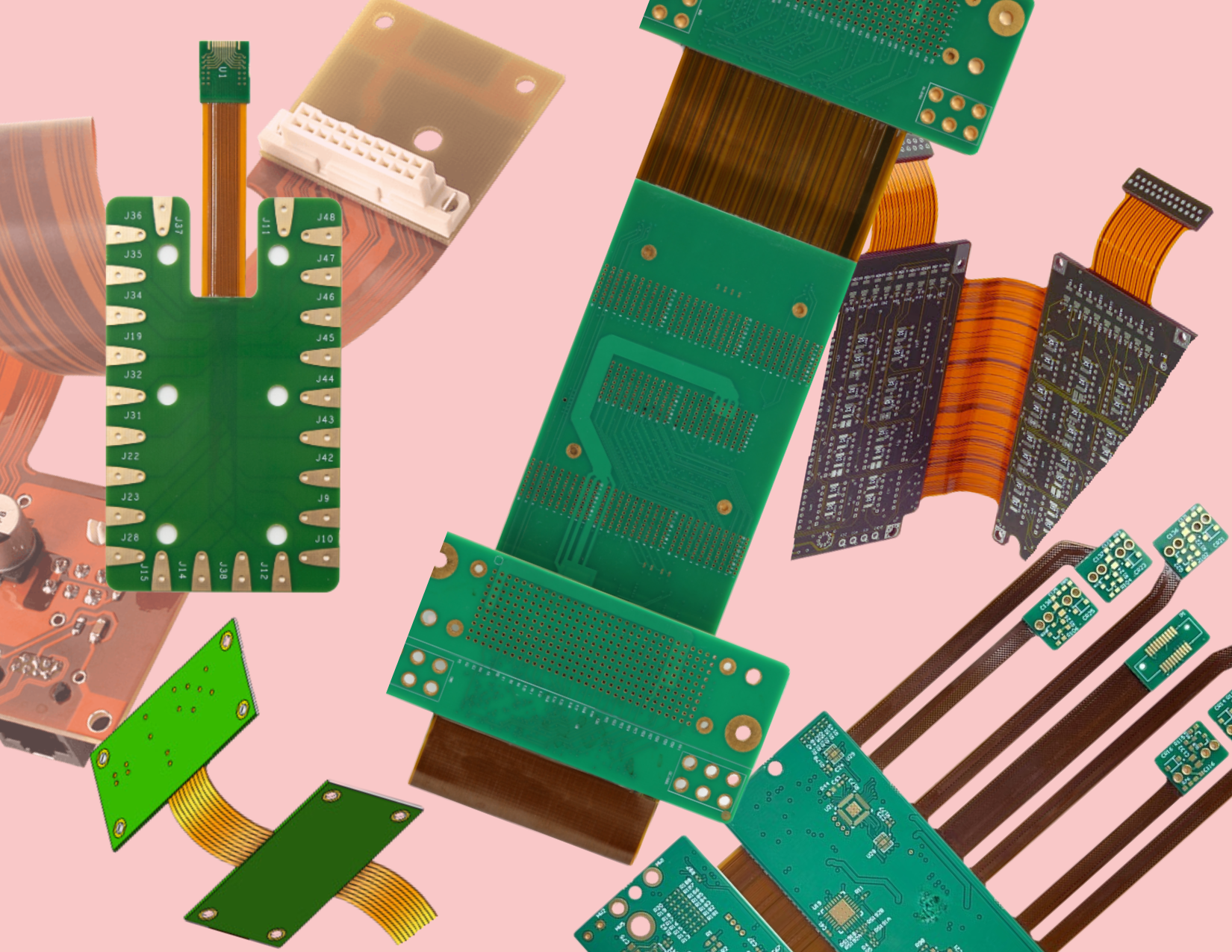
What are the main features of Rigid-Flex PCBs?
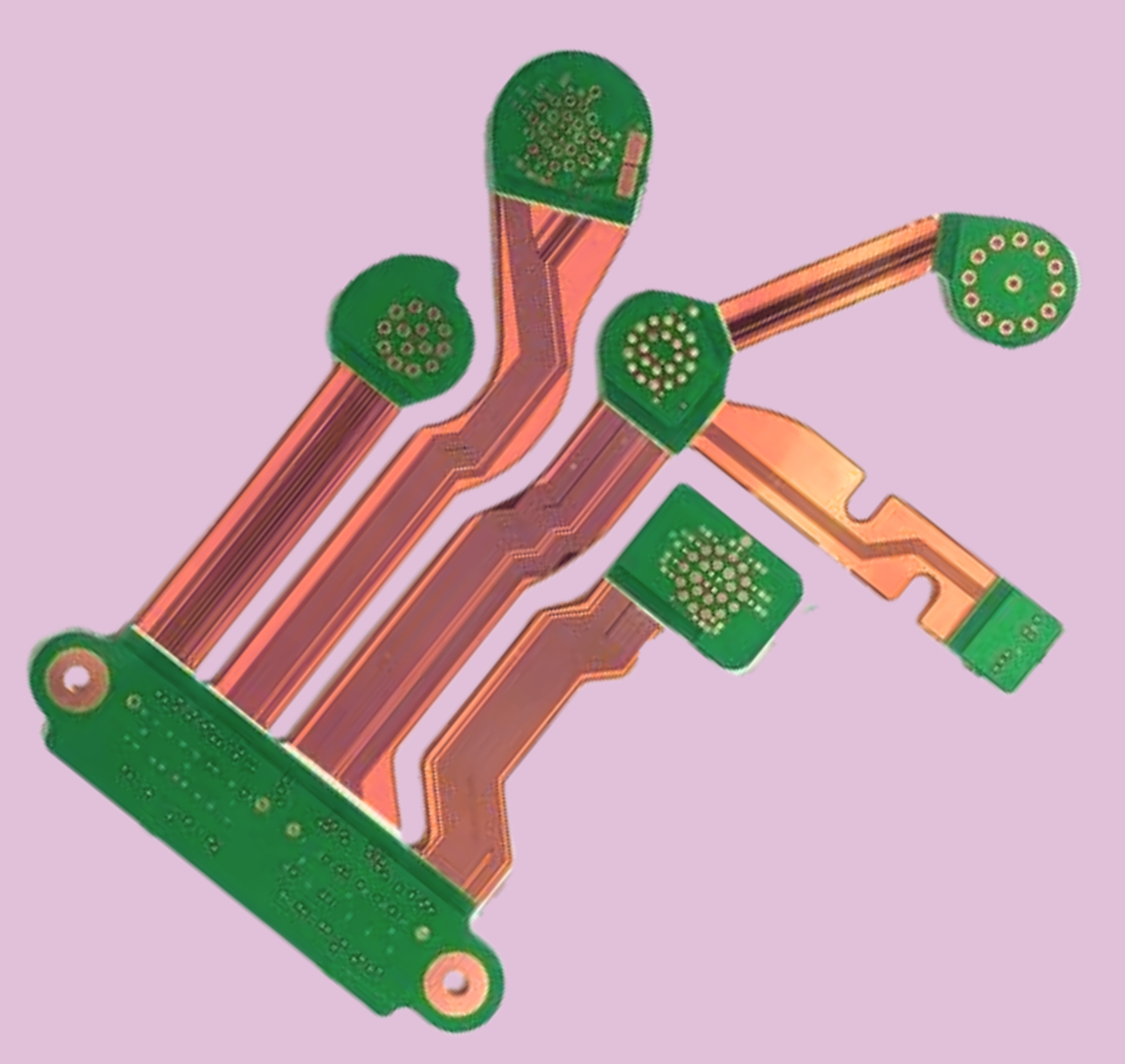
The Flex PCB (Flexible printed circuit board) utilizes a flexible polymer core, usually polyimide (PI) or polyester (PET), Copper foil - which is used for conductive surface with adhesives and coverlays which are used for bonding and insulation.
Due to the design versatility and special structural design, the Rigid Flex PCB has special features like:
1. Enhanced Reliability with Durability:
The flexible portion requires fewer connectors and cables, eliminating potential failure points, thus improving functionality and reliability. A trusted flex rigid PCB manufacturer ensures the flexible sections withstand mechanical stress, vibrations, and temperature variations, making the boards ideal for harsh environments.
The Flexible section of the Rigid Flex Board can withstand the mechanical stress, vibrations, heat dissipation, temperature variations etc. makes the board work efficiently in harsh environments. The Rigid Flex Boards are less susceptible to failure at work after bending, twisting or vibration exposure due to the unique Flex inside.
2. Hybrid Design:
Rigid-flex PCBs have a facility of building multiple layers; some layers are prepared from Rigid material (standard PCBs) and multiple inner layers are of flexible PCB. (flex circuits).
3. Design Versatility:
The Rigid Flex PCB allows greater design flexibility as compared to the regular Rigid PCB or just a Flex PCB, because the flexible section can be bent, fold or twisted to accommodate and connect hard to reach components in a compact device. The Rigid Flex Boards are having innovative designs to fit and work in complex applications with 3D spaces.
4. HDI Rigid Flex:
This Type of PCB allows more complex and compact designs having more than one flexible section in 10-12- or 14-layers board and they can get interconnected with via drills. These are the complex Rigid Flex PCBs.
5. Thermal Management:
The Rigid Flex PCB are having design advancements keeping the thermal management in mind such a way to dissipate heat efficiently, incorporating some special features like using low CTE substrates, aluminum heat sinks, localized selective copper planes on inner or outer layers etc. that facilitate the distribution of heat throughout the flex circuits. This feature ensures the Rigid Flex Board working reliably under extreme operating conditions.
6. Light weight and Space saving:
Some of the high-tech devices that perform complex operations in aerospace, aviation, medical devices, high tech electronics etc. needs to be compact and light in weight and this feature can be achieved by using Rigid Flex PCB because these boards are structured in such a way using multi layers of Rigid and Flex that eliminates the need for connectors and cables in flexible sections resulting in a smaller overall footprint.
7. Material integration:
There are two sections in Rigid Flex PCB, the Rigid area and the Flex area. The Rigid area is typically the FR-4 which provides strength and mechanical support, whereas the Flexible sections are of Polyimide material with are used for flexibility and heat resistance which facilitates the flex curves in installation. This combination of materials makes the Rigid Flex Board a robust and reliable in performance.
This unique combination of materials in a Rigid Flex PCB creates a 3D design capability facilitating the designers to twist, fold and bend the flexible board to achieve their desired shape according to the final application’s module.
8. Simplified Assembly:
Due to the customized hybrid design of the Rigid Flex PCB, it reduces the need of connectors, complex interconnects and cables which ease the assembly process by reducing errors.
What materials are used to build Rigid-Flex PCBs?
Rigid Flex Board is a fusion of two different things, it comprises of Rigid and Flex two parts, which includes FR-4 like material as a rigid part and Polyimide (PI) like materials for the Flex part. There are some other materials that include adhesive, substrate, copper foil, cover lay, adhesive less PI, solder mask, silk screen, stiffener etc. used to build the boards.
Here's a more detailed explanation of the materials:

Rigid Section :
Depending on the requirement of the application, several Rigid Materials are available to use for the Rigid Section that include Standard FR-4, High TG FR-4, Lead free compatible FR-4, RF and Microwave compatible material, High Speed Digital material, Aluminum (metal core) material, Copper core and some others.
The upper Rigid part includes some other materials listed below:
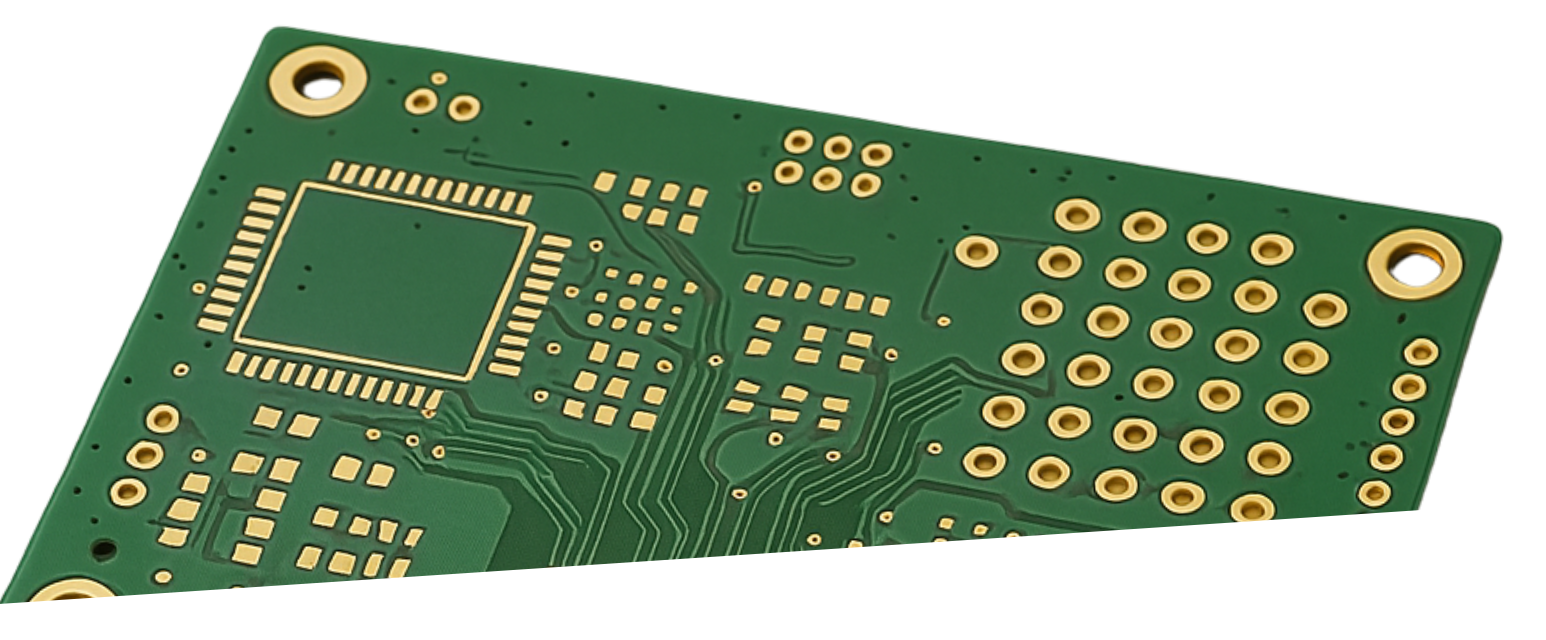
- Silk screen: A nomenclature layer that has markings and labelling for PCB.
- Solder Mask: A layer that protects the surface of the PCB which is often a polymer, is used to prevent the solder from bridging between traces.
- Copper Foil: Thin copper foil of different thickness is used to develop traces and pads as a conductive layer.
- Adhesive: Adhesive is used to bond different layers on the Rigid Section.
- Stiffeners: Depending on the requirements of some applications, stiffeners made up of FR-4, Polyimide, Aluminum, Copper, Steel etc. are used.
Flexible Sections:
- Substrate: The main material of the Flexible PCB which is Polyimide (PI) film etc. is known for its flexibility, durability and heat resistance.
- Copper Foil: Thin copper foil of different thickness is used to develop traces and pads as a conductive layer.
- Cover lay: A thin protective layer of Polyimide which is used to cover the flex area of the PCB and to protect the copper traces and pads. (conductive layer)
- Adhesive less PI: In some applications, the adhesive less PI is used to bond copper directly with the Polyimide material to reduce the board thickness and for some other benefits of flex design.
- Adhesive: : Adhesive materials are used to bond the copper foil with the Polyimide substrate and to bond the cover lay with the copper foil.
On the outer most surface of the PCB, to protect the exposed copper from Oxidation and Corrosion there are several types of finishes are used. The most common finish for Rigid Flex PCB is ENIG, some other finishes include Hard Gold Fingers, Immersion Tin, Immersion Silver, ENEPIG etc.
We are happy to assist you in selecting the proper finish type according to the application’s requirement that will improve the functionality and self-life.
What are the technical aspects, structure and characteristics of Rigid-Flex PCBs?
Rigid Flex Printed Circuit Boards combine a Rigid and a Flexible section in which the Rigid part is made up of epoxy resin FR-4 material and the Flexible part is made up of Polyimide Flex material which results in enhanced flexibility, reliability, space efficiency, light weight and facilitates integration in multiple PCB assembly enabling complex geometries and 3D designs.
Detailed technical aspects of Rigid-Flex PCBs are listed below:
Material Composition:
- Rigid Section:Fiberglass reinforced epoxy resin material usually FR-4, which is used to provide mechanical strength and stability for the board.
- Adhesives:Specialized adhesives are used to bond the Rigid and Flexible parts ensuring a strong and reliable connection.
- Flexible Section:Polyimide material (PI) which is flexible in nature having dielectric strength and heat resistance.
- Layer Construction:Commonly the Rigid Flex boards are made up of 4 layers to 20-layer construction per the requirements of an application. There may be one or more flex layers embedded in the construction, all the layers are interconnected by via drills and other component holes facilitating the complex circuitry and high-density interconnections.
- Design:The Rigid Flex Boards are designed with complex technology with 3D designs allowing specific geometries and efficient space utilization. The Flexible section can be bent or folded to reach tight spaces, but the minimum bent radius and bend side needs to be considered while designing the board stack up.
- Design considerations and manufacturing:As the Rigid Flex Board gets the higher number of layers with complex technology, several design aspects need to be taken care of including band radius-an important factor, via placements, material compatibility etc. Also, there are multiple steps involved in fabrication like material preparation, drilling, plating, lamination, etching, surface treatment, testing, routing etc.
- The Rigid Flex Boards provides certain advantages like flexibility which absorbs shocks and vibrations, improves durability and reliability of the device with better thermal management and heat dissipation, can work in harsh environments of heat and vibrations, space saving enabling compact device design and leads to reduce the assembly costs.
Some Technical Specifications are listed below in a tabular form:
| Technical Description | |
|---|---|
| Layer Counts | 4 layers to 20 layers |
| Materials | FR-4 + Polyimide Flex (PI) |
| Copper Weight | Per application requirements,1 to 20 Oz. outer and 0.5 to 3 Oz. inners |
| Thickness | 0.2 mm to 3.2 mm |
| Soder Mask | Special category masks in different colors. |
| Surface Finish | ENIG, Immersion Silver, Hard Gold, OSP, etc. |
| Technology | Multi Flex structure, Heatsink application, Blind/Buried via, Micro via, Control Impedance, Penalization (array), Shielding, PSAs etc. |
Structure:
Most Rigid Flex Boards have multiple flex substrates inside the stack up and multiple Rigid sections attached on external or internal design parts because the Rigid Flex Printed Circuit Board is the hybridization of Rigid and Flex board technology designed per the requirements of an application.
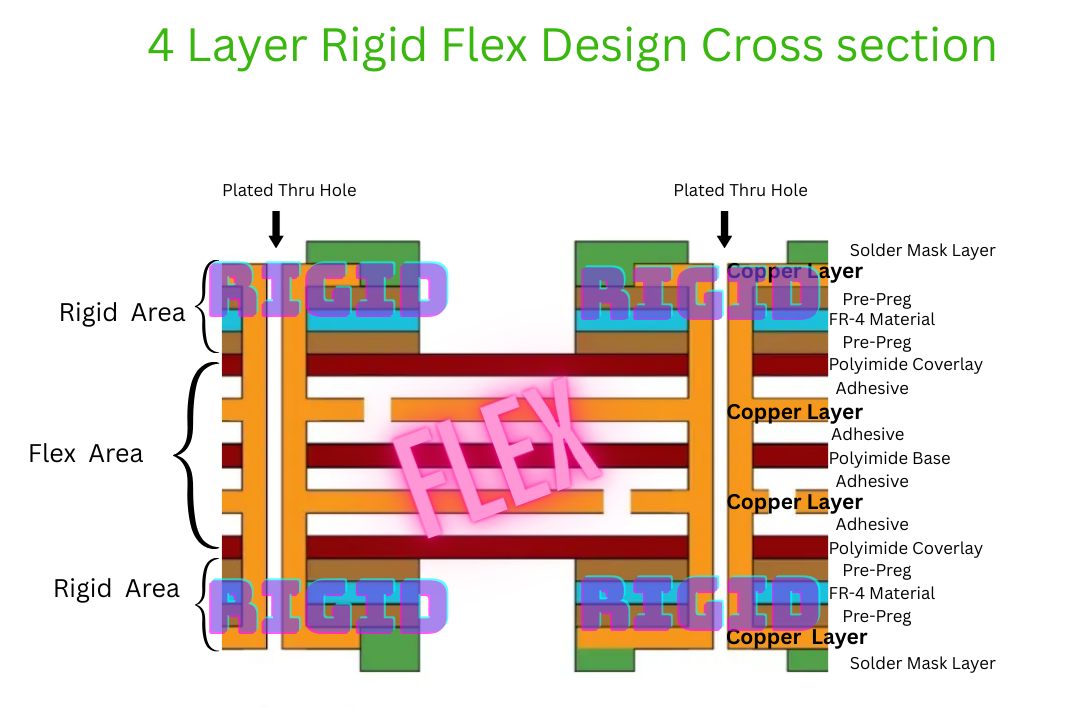
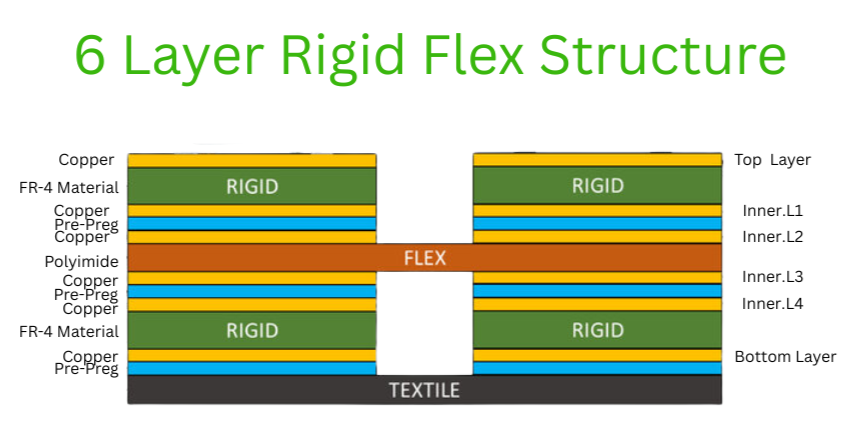
Characteristics:
Superior characteristic of the Hybrid Construction of Rigid Flex Printed Circuit Board makes them one of the most important Circuit Board in the Electronic Industry.
Some of their characteristics are listed below:
Thus, the Rigid-Flex PCB combines rigid and flexible sections, making a unique blend of structural stability and flexibility for complex, space-constrained electronic devices allowing 3D design capability, reduced weight and enhanced reliability.
The Flex Rigid PCB or Rigid Flex PCB are having a list of characteristics for the application like, hybrid design with 3D design freedom, flexibility and rigidity, enhanced reliability, high circuit density, thermal dissipation, heat resistance, improved signal integrity, reduced weight, space saving features, durability, connectivity to more areas in smaller space, chemical resistance, vibration proof, working reliably in harsh conditions and high temperatures etc.
What are the advantages of using Rigid-Flex PCBs?
The unique Printed Circuit Board- A Rigid-Flex PCB is one of its kinds that plays a versatile role in any modern high-tech electronics. It provides several advantages like:
-
Design flexibility:
It allows engineers to design with its complexity in such a way that it can connect multiple areas in the application with less assembly parts mounted on it. Thanks to its customized shape and configuration.
-
Customization with Compact Design:
On a single Rigid Flex Printed Circuit Board, the designer can integrate multiple functionalities with compact and lightweight design resulting in less need for the Rigid Boards and connectors in an individual application.
-
3D Design Capabilities and Interconnection:
Due to the flexible nature of the Rigid Flex PCB the interconnections are made possible in innovative solutions and allow the 3D configurations maximizing the space utilization in compact enclosures. This is a need in today’s modern electronics.
-
Space Efficiency and Better Flexibility:
The Flex Rigid Boards are designed in such a way that integrate the benefits of Flex PCB and a Rigid Board, combining both reduces the requirements of connectors and solder joints, this versatile design provides strength and flexibility in a single board. This design can adapt complex and irregular geometries hence can fit into tiny spaces allowing different shapes and arrangements. Flexibility is measured in terms of how much the materials can be bent and what radius, also how many times the board can be bent depending on the board design, layer stack up and requirements of an application.
-
Thermal Management and High-Speed Signal Performance:
Using Low CTE substrate the Flex Rigid Board has advanced thermal management with signal integration, also their custom design helps maintain signal integrity in high-speed applications and makes the devices reliable under extreme operating conditions.
-
Reliability:
Enhanced reliability can be achieved in Rigid Flex PCBs with space and weight saving features with the ability to withstand hard conditions and extreme temperatures. When application in the fields of Aerospace, Aviation, High Tech Medical devices, Advance Electronics etc. requires flexibility with reliability, Rigid Flex Printed Circuit Board proves always a better option.
-
Stability:
The combination of Rigid and Flex sections provides mechanical stability to the mechanism that absorbs shocks and vibrations, reduces cracking of circuits and provides the durability that results in the electronic device to perform consistently until a long, while working in adverse conditions.
-
Reduced Weight:
Comparing to the regular Rigid PCB, the hybrid design of the Flex Rigid PCB contributes the weight reduction of the board, that benefits insertion in portable and compact devices which are light in weight.
The complex and unique construction of Flex Rigid PCB is more beneficial in small and compact yet complex devices to fit inside and save space. Also, an added benefit is that we can reduce the use of connectors and cables on this PCB that results in reducing the cost of assembly and manufacturing.
All these features make the Rigid Flex Printed Circuit Board an ideal choice for space-constrained portable devices.
What are the different applications of Rigid-Flex PCB?
In today’s modern electronic world, Rigid-flex PCB offers a versatile solution in a variety of fields. Having flexibility, durability and reliability, they can withstand harsh environments. Their complex design makes them play a crucial role in a wide range of Industries.
Let’s have a look at some important fields where Rigid Flex PCBs are widely used:
Consumer Electronics
Devices like smart phones, wearables, laptops and tablets, camara and other portable devices have a wide use of Flex Rigid PCB inside due to its flexibility, ability to connect the components in compact area and a lightweight design.
Automotive Industry
Some of the important applications in automobiles like ADAS (Advanced Driver Assistance System), infotainment systems, lighting systems, airbag systems, antilock brakes, GPS systems, engine control systems etc. are widely using the Rigid Flex PCB due to their ability to perform reliably in harsh environments, easy to connect components in small areas, flexibility etc.
Military
In a military field, the low weight Rigid Flex PCBs are widely used due to their characteristics of light weight, heat dissipation, temperature resistance, flexibility and ability to connect various components in application, requiring less assembly parts, being able to work in harsh environments etc. also helps to reduce fuel consumption in weapons.
Aerospace
Aviation system requires the applications to run in adverse and harsh environments in a different temperature range, the Flex Rigid PCB are best fit for several aviation devices.
Medical Industry
Some of the major technologies like Pacemakers and medical implants have an advantage of rigid-flex PCB because they occupy less space and have a lower volume which is best suited for implants. Lots of other medical devices use the Rigid Flex PCB due to their unique properties.
Industrial Sectors
Rigid flex PCBs are widely used in industrial applications such as CNC machines, stepper motors and other equipment. Due to its flexible nature this type of PCB is extremely helpful for rotational and mechanical movements. A lot of other industrial mechanisms can use the Flex Rigid PCBs.
Some other applications in contract manufacturing, high speed digital equipment, LED lighting, RF and Microwave equipment, Instrumentation, power electronics etc. are widely using the Rigid Flex Printed Circuit Boards due to their exceptional properties.
Why choose Circuitek Solutions Inc. for Rigid-Flex PCB manufacturing?
Rigid Flex Printed Circuit Boards are one of the most important and costliest boards in PCB Industry. To choose the right Manufacturer for the Rigid Flex PCB is itself a win.
Our enthusiast team of skillful workers at Circuitek Solutions Inc. are committed to dedication and perfection and are always ready to provide the highest quality Printed Circuit Boards.
With over 15 years of excellence in the industry, we use our expert engineering skills, customized working procedures, abiding IPC standards backed by ISO, UL and other certifications, we are committed to proving what we can do best to get you a high quality and reliable Printed Circuit Boards at competitive prices.
And yes, we stand behind our product with superior customer service right from design, pre-engineering to fabrication process, ensuring delivery of the right product as it needs to work efficiently with your application.
We serve Flex Rigid Printed Circuit Board manufacturing with Hybrid and Mixed Dielectric, Sequential Lamination, Buried Capacitance, Cavity PCB, Impedance Control, Buried and Blind Via, Conductive and Non-Conductive via fill, Depth Control drill and rout, Back drill process, Edge Plating, Etch Back, Beveling, Barcode printing with Aluminum or other Stiffeners etc.
Let’s connect today, our team of experts are happy to answer any of your questions, anything from design to manufacturing of the Rigid Flex Printed Circuit Boards. Also, you can get a no obligation and a quick quote for any of your prototype to low, medium or high volume of Rigid Flex Printed Circuit Boards
Also take advantage of our ongoing“50% off on tooling cost” offer for your first five orders.
Interested in what we offer?
Get in touch with us to
find out how
we can help you!
Frequently Asked Questions
Whereas the Rigid Flex Circuit Board is made up of a combination of Rigid Material and Polyimide Flex (PI) material which has mechanical strength with better heat and thermal resistance with bendable capabilities. The manufacturing process is often critical and is costly.